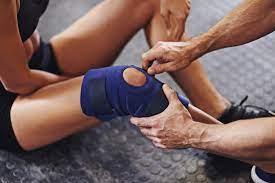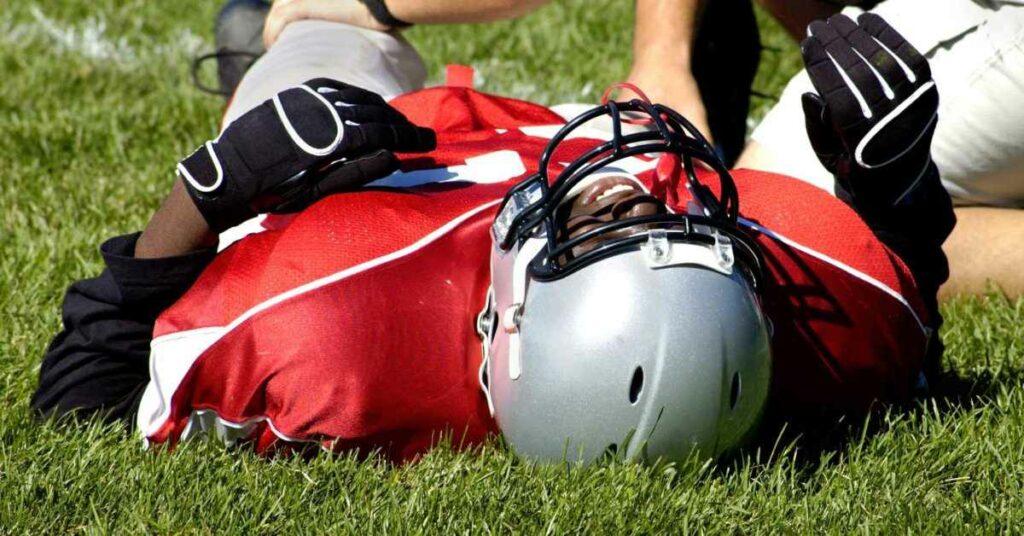Lateral collateral ligament sprain, also known as LCL sprain, is a type of ankle sprain that affects the lateral side of the ankle. It occurs when the ankle is twisted inwards and the foot rolls over onto its outer edge. This injury can cause pain, swelling, and instability in the ankle. In this blog post, we will explore the causes, treatment, and prevention of lateral collateral ligament sprains.
Contents
- 1 What Is Lateral Collateral Ligament Sprain?
- 2 What Are the Symptoms of Lateral Collateral Ligament Sprain?
- 3 What Causes Lateral Collateral Ligament Sprain?
- 4 Who Is at Risk for Lateral Collateral Ligament Sprain?
- 5 How Is It Diagnosed?
- 6 What Are The treatment options?
- 7 What are the preventive measures?
- 8 Conclusion
What Is Lateral Collateral Ligament Sprain?

The lateral collateral ligament (LCL) is a strong band of tissue that runs down the outside of your knee. It connects your femur (thighbone) to your fibula (smaller bone in your lower leg) and helps to stabilize your knee joint.
A lateral collateral ligament sprain is an injury to this ligament. It can range from a mild stretching of the ligament to a complete tear. Most LCL sprains happen when the knee is bent and hit from the outside. This force stretches or tears the ligament.
LCL sprains are less common than medial collateral ligament (MCL) sprains, which occur on the inside of the knee.
What Are the Symptoms of Lateral Collateral Ligament Sprain?

The symptoms of an LCL sprain depend on the severity of the injury.
Mild (Grade I): There is a stretched ligament with some micro-tearing. You may have pain on the outside of your knee. You may also have tenderness and swelling.
Moderate (Grade II): There is a partial tear of the ligament. You will have pain and tenderness on the outside of your knee. The pain may be severe. You will also have swelling and bruising. Your knee may feel unstable when you walk or put weight on it.
Severe (Grade III): There is a complete tear of the ligament. You will have severe pain and tenderness on the outside of your knee. The knee may feel unstable and you may not be able to put weight on it. You will also have swelling and bruising.
What Causes Lateral Collateral Ligament Sprain?
The various causes of lateral collateral ligament sprain are as follows:
Overuse
Repetitive stress on the ligament can cause it to become stretched or torn. This is often seen in athletes who participate in sports that involve a lot of cutting and pivoting, such as soccer, basketball, and tennis. For instance, a soccer player may make a sharp turn to avoid an opponent and end up straining their lateral collateral ligament. A direct blow to your knees, such as from a fall or car accident, can cause a lateral collateral ligament sprain
Acute injury
A single, traumatic event can also cause a lateral collateral ligament sprain. This might happen if you fall and land on your knee, or if you get hit by a hard object, such as a football. a football player who’s tackled from the side might suffer a lateral collateral ligament sprain.
Chronic injury
In some cases, repetitive stress to the joint can lead to a lateral collateral ligament sprain. This is more common in athletes who participate in sports that involve a lot of cutting and pivoting motions, such as soccer, basketball, and tennis. A tennis player might develop a lateral collateral ligament sprain from repeatedly hitting the ball with a topspin. This causes the kneecap to rotate outward, which puts stress on the ligament.
Weakness
If the muscles around your knee are weak, it can put extra stress on the lateral collateral ligament, making it more susceptible to injury. if you have weak quadriceps muscles, your kneecap may not track properly. This can cause the kneecap to rub against the lateral collateral ligament, weakening it over time and making it more susceptible to injury.
Wearing high heels
Wearing high heels regularly can also contribute to lateral collateral ligament strains. That’s because they change the way you walk and put extra pressure on your knees. Wearing shoes that don’t fit well or provide adequate support can also lead to this type of injury.A direct blow to your knees, such as from a fall or car accident, can cause a lateral collateral ligament sprain
Degenerative changes
With age, the ligaments can become weak and more susceptible to injury. For example, studies have shown that professional football players have a high incidence of collateral ligament tears, particularly of the medial collateral ligament.
Lateral collateral ligament sprains can range from mild to severe, depending on the extent of the damage. A mild sprain may only involve some stretching of the ligament, while a more severe sprain can cause the ligament to tear completely.
Who Is at Risk for Lateral Collateral Ligament Sprain?
You are at risk for an LCL sprain if you participate in any sport or activity that puts stress on the knee, such as football, soccer, rugby, skiing, and basketball. People who have had a previous LCL injury are also at risk for re-injury.
Certain underlying conditions can also increase your risk of developing an LCL sprain. These include:
Joint laxity or ligamentous laxity: People who have naturally loose or “lax” joints are more prone to sprains. This is because their ligaments don’t have to stretch as far to cause a sprain.
Repetitive use: Doing the same motion over and over again can put stress on the ligaments and lead to a sprain. This is common in athletes who play sports that involve a lot of cutting or quick changes in direction, such as basketball or soccer.
Anatomic variation: Some people are born with a more horizontal orientation of the lateral collateral ligament, which makes it more vulnerable to injury.
Obesity: Extra weight puts extra pressure on the joints and can lead to a sprain.For example, an obese person is more likely to sprain their ankle than someone who is at a healthy weight.
How Is It Diagnosed?
The diagnosis of lateral collateral ligament sprain can include:
Physical examination: This will be done by your doctor or sports medicine specialist. They will look for tenderness, swelling, and bruising along the outside of your knee. They will also test the stability of your knee joint and range of motion.
Imaging tests: An X-ray can rule out other potential causes of your pain, such as a fracture. An MRI can show the extent of damage to your ligament.
What Are The treatment options?
There are various treatment options which are as follows:
RICE(Rest Ice Compression And Elevation)
RICE stands for Rest, Ice, Compression, and Elevation. This is the most common and initial treatment for all types of ligament sprains. It helps to reduce pain and swelling. You can put an ice pack on the injured area for 20 minutes at a time, several times a day. You should also try to keep the injured area elevated above your heart as much as possible.
NSAIDs(Non-Steroidal Anti-inflammatory Drugs)
NSAIDs help to reduce both pain and inflammation. Ibuprofen and naproxen are some of the most common NSAIDs. You can buy them over the counter at your local drug store.
Corticosteroid Injections
Corticosteroid injections are another option for treating ligament sprains. They contain a type of corticosteroid medication that helps to reduce inflammation. The injection is usually given directly into the injured area.
Physical Therapy
Physical therapy can also be helpful in treating ligament sprains. A physical therapist can teach you exercises that will help to strengthen the muscles around your injured area. This can help to prevent future injuries.
Surgery
In severe cases, where the ligament is completely torn, surgery may be required to repair it.For instance, a person who has an active lifestyle or is a professional athlete may opt for surgery so that they can return to their previous level of activity.
Recovery
After the ligament has healed, physical therapy may be necessary to help strengthen the joint and prevent further injury. Most people make a full recovery within six months to a year.
What are the preventive measures?
There are various preventive measures that can be taken to avoid lateral collateral ligament sprains and they are as follows:
Wearing proper shoes: Wearing shoes with good arch support and shock-absorbing soles can help to prevent ligament sprains. For example, wearing shoes with good arch support can help to prevent medial collateral ligament sprains.
Avoiding high-risk activities: Avoiding activities that put you at risk of suffering a lateral collateral ligament sprain can help to prevent the injury. For instance, if you play contact sports such as football or rugby, you should wear appropriate protective gear to help reduce your risk of suffering a lateral collateral ligament sprain.
Strengthening the muscles around the knee: Strong muscles around the knee can help to support the joint and prevent ligament sprains. You can strengthen the muscles around your knee by doing exercises such as squats, lunges, and leg presses.
Warm-up exercises: It is important to do warm-up exercises before participating in any physical activity as it helps to increase the blood flow and flexibility of the muscles and ligaments. For example, take a brisk walk for 10 minutes or do some light stretching exercises.
Stretching and strengthening exercises: Doing stretching exercises regularly helps to improve the flexibility of the muscles and ligaments and thus reduces the risk of injury. The following strengthening exercises can be done for an LCL sprain:
Side-lying leg lift: Lie on your side with the affected leg on top. Use a towel roll under your hip if needed. Bend your knee and raise your leg until it is in line with your body. Return to the starting position.
Static quadriceps set: Sit on the floor with a towel rolled under your affected knee. Tighten the muscles on the front of your thigh and hold for 5 to 10 seconds. Repeat 10 times.
Proper training: It is important to follow proper training methods while participating in any sport or physical activity to avoid injuries.
Avoiding high-risk activities: Activities that put undue stress on the ligaments should be avoided to prevent ligament sprains.
Bracing or taping: This is done to provide support to the affected ligament and prevent further injury. For instance, an athlete who has suffered an LCL sprain may wear a hinged knee brace during competition.
Conclusion
It may be concluded that lateral collateral ligament sprain is a common knee injury that can occur due to various reasons. The most effective treatment for this condition is RICE therapy which stands for rest, ice, compression, and elevation. However, it is important to consult a doctor before starting any kind of treatment. In order to prevent lateral collateral ligament sprain, one should avoid sudden changes in direction while playing sports and maintain good flexibility by stretching regularly.
Physical Therapy help patients recover from pain. If you’re experiencing Back pain, Shoulder pain, Knee pain, Neck pain, Elbow pain, Hip pain, or Arthritis pain, a physical therapist at MantraCare can help: Book a physiotherapy session.


